Yiqiang Yan
EffOWT: Transfer Visual Language Models to Open-World Tracking Efficiently and Effectively
Apr 09, 2025Abstract:Open-World Tracking (OWT) aims to track every object of any category, which requires the model to have strong generalization capabilities. Trackers can improve their generalization ability by leveraging Visual Language Models (VLMs). However, challenges arise with the fine-tuning strategies when VLMs are transferred to OWT: full fine-tuning results in excessive parameter and memory costs, while the zero-shot strategy leads to sub-optimal performance. To solve the problem, EffOWT is proposed for efficiently transferring VLMs to OWT. Specifically, we build a small and independent learnable side network outside the VLM backbone. By freezing the backbone and only executing backpropagation on the side network, the model's efficiency requirements can be met. In addition, EffOWT enhances the side network by proposing a hybrid structure of Transformer and CNN to improve the model's performance in the OWT field. Finally, we implement sparse interactions on the MLP, thus reducing parameter updates and memory costs significantly. Thanks to the proposed methods, EffOWT achieves an absolute gain of 5.5% on the tracking metric OWTA for unknown categories, while only updating 1.3% of the parameters compared to full fine-tuning, with a 36.4% memory saving. Other metrics also demonstrate obvious improvement.
ArtCrafter: Text-Image Aligning Style Transfer via Embedding Reframing
Jan 03, 2025



Abstract:Recent years have witnessed significant advancements in text-guided style transfer, primarily attributed to innovations in diffusion models. These models excel in conditional guidance, utilizing text or images to direct the sampling process. However, despite their capabilities, direct conditional guidance approaches often face challenges in balancing the expressiveness of textual semantics with the diversity of output results while capturing stylistic features. To address these challenges, we introduce ArtCrafter, a novel framework for text-to-image style transfer. Specifically, we introduce an attention-based style extraction module, meticulously engineered to capture the subtle stylistic elements within an image. This module features a multi-layer architecture that leverages the capabilities of perceiver attention mechanisms to integrate fine-grained information. Additionally, we present a novel text-image aligning augmentation component that adeptly balances control over both modalities, enabling the model to efficiently map image and text embeddings into a shared feature space. We achieve this through attention operations that enable smooth information flow between modalities. Lastly, we incorporate an explicit modulation that seamlessly blends multimodal enhanced embeddings with original embeddings through an embedding reframing design, empowering the model to generate diverse outputs. Extensive experiments demonstrate that ArtCrafter yields impressive results in visual stylization, exhibiting exceptional levels of stylistic intensity, controllability, and diversity.
Learning Interaction-aware 3D Gaussian Splatting for One-shot Hand Avatars
Oct 11, 2024



Abstract:In this paper, we propose to create animatable avatars for interacting hands with 3D Gaussian Splatting (GS) and single-image inputs. Existing GS-based methods designed for single subjects often yield unsatisfactory results due to limited input views, various hand poses, and occlusions. To address these challenges, we introduce a novel two-stage interaction-aware GS framework that exploits cross-subject hand priors and refines 3D Gaussians in interacting areas. Particularly, to handle hand variations, we disentangle the 3D presentation of hands into optimization-based identity maps and learning-based latent geometric features and neural texture maps. Learning-based features are captured by trained networks to provide reliable priors for poses, shapes, and textures, while optimization-based identity maps enable efficient one-shot fitting of out-of-distribution hands. Furthermore, we devise an interaction-aware attention module and a self-adaptive Gaussian refinement module. These modules enhance image rendering quality in areas with intra- and inter-hand interactions, overcoming the limitations of existing GS-based methods. Our proposed method is validated via extensive experiments on the large-scale InterHand2.6M dataset, and it significantly improves the state-of-the-art performance in image quality. Project Page: \url{https://github.com/XuanHuang0/GuassianHand}.
GarmentAligner: Text-to-Garment Generation via Retrieval-augmented Multi-level Corrections
Aug 23, 2024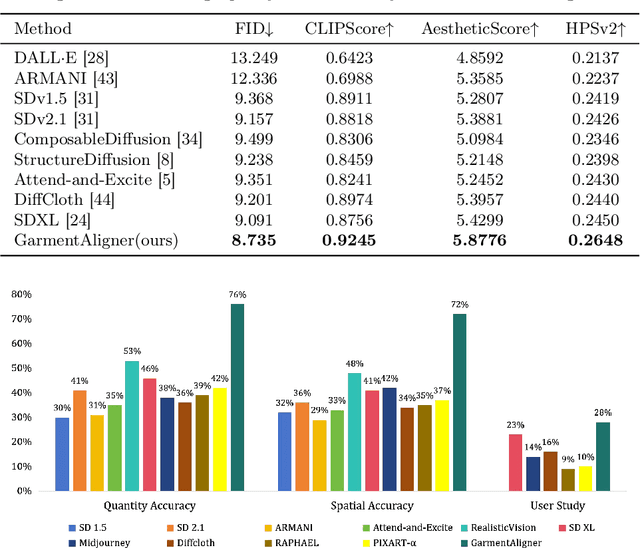



Abstract:General text-to-image models bring revolutionary innovation to the fields of arts, design, and media. However, when applied to garment generation, even the state-of-the-art text-to-image models suffer from fine-grained semantic misalignment, particularly concerning the quantity, position, and interrelations of garment components. Addressing this, we propose GarmentAligner, a text-to-garment diffusion model trained with retrieval-augmented multi-level corrections. To achieve semantic alignment at the component level, we introduce an automatic component extraction pipeline to obtain spatial and quantitative information of garment components from corresponding images and captions. Subsequently, to exploit component relationships within the garment images, we construct retrieval subsets for each garment by retrieval augmentation based on component-level similarity ranking and conduct contrastive learning to enhance the model perception of components from positive and negative samples. To further enhance the alignment of components across semantic, spatial, and quantitative granularities, we propose the utilization of multi-level correction losses that leverage detailed component information. The experimental findings demonstrate that GarmentAligner achieves superior fidelity and fine-grained semantic alignment when compared to existing competitors.
AutoStudio: Crafting Consistent Subjects in Multi-turn Interactive Image Generation
Jun 03, 2024Abstract:As cutting-edge Text-to-Image (T2I) generation models already excel at producing remarkable single images, an even more challenging task, i.e., multi-turn interactive image generation begins to attract the attention of related research communities. This task requires models to interact with users over multiple turns to generate a coherent sequence of images. However, since users may switch subjects frequently, current efforts struggle to maintain subject consistency while generating diverse images. To address this issue, we introduce a training-free multi-agent framework called AutoStudio. AutoStudio employs three agents based on large language models (LLMs) to handle interactions, along with a stable diffusion (SD) based agent for generating high-quality images. Specifically, AutoStudio consists of (i) a subject manager to interpret interaction dialogues and manage the context of each subject, (ii) a layout generator to generate fine-grained bounding boxes to control subject locations, (iii) a supervisor to provide suggestions for layout refinements, and (iv) a drawer to complete image generation. Furthermore, we introduce a Parallel-UNet to replace the original UNet in the drawer, which employs two parallel cross-attention modules for exploiting subject-aware features. We also introduce a subject-initialized generation method to better preserve small subjects. Our AutoStudio hereby can generate a sequence of multi-subject images interactively and consistently. Extensive experiments on the public CMIGBench benchmark and human evaluations show that AutoStudio maintains multi-subject consistency across multiple turns well, and it also raises the state-of-the-art performance by 13.65% in average Frechet Inception Distance and 2.83% in average character-character similarity.
Rethink Predicting the Optical Flow with the Kinetics Perspective
May 21, 2024Abstract:Optical flow estimation is one of the fundamental tasks in low-level computer vision, which describes the pixel-wise displacement and can be used in many other tasks. From the apparent aspect, the optical flow can be viewed as the correlation between the pixels in consecutive frames, so continuously refining the correlation volume can achieve an outstanding performance. However, it will make the method have a catastrophic computational complexity. Not only that, the error caused by the occlusion regions of the successive frames will be amplified through the inaccurate warp operation. These challenges can not be solved only from the apparent view, so this paper rethinks the optical flow estimation from the kinetics viewpoint.We propose a method combining the apparent and kinetics information from this motivation. The proposed method directly predicts the optical flow from the feature extracted from images instead of building the correlation volume, which will improve the efficiency of the whole network. Meanwhile, the proposed method involves a new differentiable warp operation that simultaneously considers the warping and occlusion. Moreover, the proposed method blends the kinetics feature with the apparent feature through the novel self-supervised loss function. Furthermore, comprehensive experiments and ablation studies prove that the proposed novel insight into how to predict the optical flow can achieve the better performance of the state-of-the-art methods, and in some metrics, the proposed method outperforms the correlation-based method, especially in situations containing occlusion and fast moving. The code will be public.
TheaterGen: Character Management with LLM for Consistent Multi-turn Image Generation
Apr 29, 2024



Abstract:Recent advances in diffusion models can generate high-quality and stunning images from text. However, multi-turn image generation, which is of high demand in real-world scenarios, still faces challenges in maintaining semantic consistency between images and texts, as well as contextual consistency of the same subject across multiple interactive turns. To address this issue, we introduce TheaterGen, a training-free framework that integrates large language models (LLMs) and text-to-image (T2I) models to provide the capability of multi-turn image generation. Within this framework, LLMs, acting as a "Screenwriter", engage in multi-turn interaction, generating and managing a standardized prompt book that encompasses prompts and layout designs for each character in the target image. Based on these, Theatergen generate a list of character images and extract guidance information, akin to the "Rehearsal". Subsequently, through incorporating the prompt book and guidance information into the reverse denoising process of T2I diffusion models, Theatergen generate the final image, as conducting the "Final Performance". With the effective management of prompt books and character images, TheaterGen significantly improves semantic and contextual consistency in synthesized images. Furthermore, we introduce a dedicated benchmark, CMIGBench (Consistent Multi-turn Image Generation Benchmark) with 8000 multi-turn instructions. Different from previous multi-turn benchmarks, CMIGBench does not define characters in advance. Both the tasks of story generation and multi-turn editing are included on CMIGBench for comprehensive evaluation. Extensive experimental results show that TheaterGen outperforms state-of-the-art methods significantly. It raises the performance bar of the cutting-edge Mini DALLE 3 model by 21% in average character-character similarity and 19% in average text-image similarity.
Real-Time 4K Super-Resolution of Compressed AVIF Images. AIS 2024 Challenge Survey
Apr 25, 2024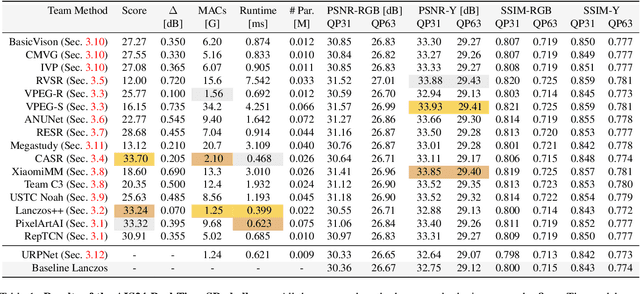

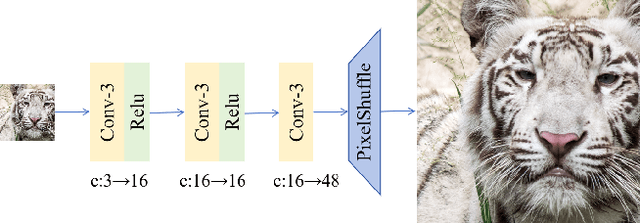
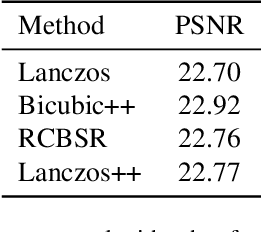
Abstract:This paper introduces a novel benchmark as part of the AIS 2024 Real-Time Image Super-Resolution (RTSR) Challenge, which aims to upscale compressed images from 540p to 4K resolution (4x factor) in real-time on commercial GPUs. For this, we use a diverse test set containing a variety of 4K images ranging from digital art to gaming and photography. The images are compressed using the modern AVIF codec, instead of JPEG. All the proposed methods improve PSNR fidelity over Lanczos interpolation, and process images under 10ms. Out of the 160 participants, 25 teams submitted their code and models. The solutions present novel designs tailored for memory-efficiency and runtime on edge devices. This survey describes the best solutions for real-time SR of compressed high-resolution images.
ConsistentID: Portrait Generation with Multimodal Fine-Grained Identity Preserving
Apr 25, 2024



Abstract:Diffusion-based technologies have made significant strides, particularly in personalized and customized facialgeneration. However, existing methods face challenges in achieving high-fidelity and detailed identity (ID)consistency, primarily due to insufficient fine-grained control over facial areas and the lack of a comprehensive strategy for ID preservation by fully considering intricate facial details and the overall face. To address these limitations, we introduce ConsistentID, an innovative method crafted for diverseidentity-preserving portrait generation under fine-grained multimodal facial prompts, utilizing only a single reference image. ConsistentID comprises two key components: a multimodal facial prompt generator that combines facial features, corresponding facial descriptions and the overall facial context to enhance precision in facial details, and an ID-preservation network optimized through the facial attention localization strategy, aimed at preserving ID consistency in facial regions. Together, these components significantly enhance the accuracy of ID preservation by introducing fine-grained multimodal ID information from facial regions. To facilitate training of ConsistentID, we present a fine-grained portrait dataset, FGID, with over 500,000 facial images, offering greater diversity and comprehensiveness than existing public facial datasets. % such as LAION-Face, CelebA, FFHQ, and SFHQ. Experimental results substantiate that our ConsistentID achieves exceptional precision and diversity in personalized facial generation, surpassing existing methods in the MyStyle dataset. Furthermore, while ConsistentID introduces more multimodal ID information, it maintains a fast inference speed during generation.
The Ninth NTIRE 2024 Efficient Super-Resolution Challenge Report
Apr 16, 2024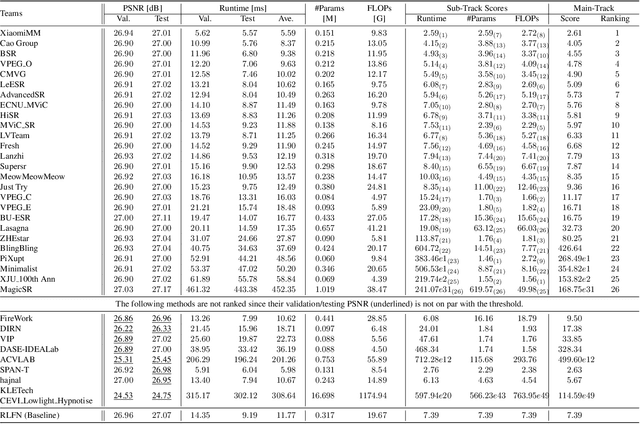
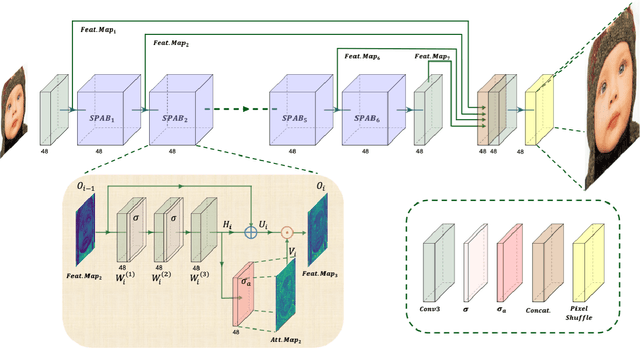


Abstract:This paper provides a comprehensive review of the NTIRE 2024 challenge, focusing on efficient single-image super-resolution (ESR) solutions and their outcomes. The task of this challenge is to super-resolve an input image with a magnification factor of x4 based on pairs of low and corresponding high-resolution images. The primary objective is to develop networks that optimize various aspects such as runtime, parameters, and FLOPs, while still maintaining a peak signal-to-noise ratio (PSNR) of approximately 26.90 dB on the DIV2K_LSDIR_valid dataset and 26.99 dB on the DIV2K_LSDIR_test dataset. In addition, this challenge has 4 tracks including the main track (overall performance), sub-track 1 (runtime), sub-track 2 (FLOPs), and sub-track 3 (parameters). In the main track, all three metrics (ie runtime, FLOPs, and parameter count) were considered. The ranking of the main track is calculated based on a weighted sum-up of the scores of all other sub-tracks. In sub-track 1, the practical runtime performance of the submissions was evaluated, and the corresponding score was used to determine the ranking. In sub-track 2, the number of FLOPs was considered. The score calculated based on the corresponding FLOPs was used to determine the ranking. In sub-track 3, the number of parameters was considered. The score calculated based on the corresponding parameters was used to determine the ranking. RLFN is set as the baseline for efficiency measurement. The challenge had 262 registered participants, and 34 teams made valid submissions. They gauge the state-of-the-art in efficient single-image super-resolution. To facilitate the reproducibility of the challenge and enable other researchers to build upon these findings, the code and the pre-trained model of validated solutions are made publicly available at https://github.com/Amazingren/NTIRE2024_ESR/.
 Add to Chrome
Add to Chrome Add to Firefox
Add to Firefox Add to Edge
Add to Edge